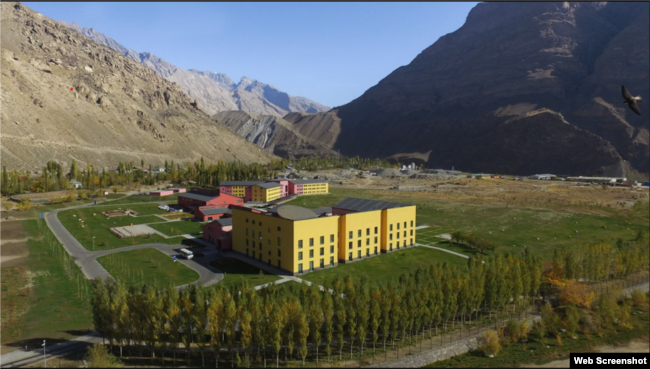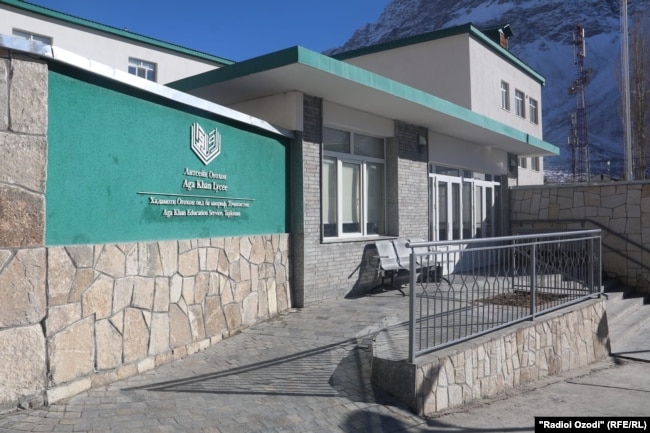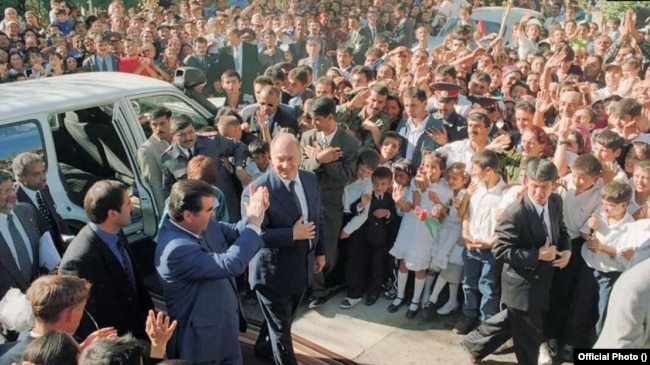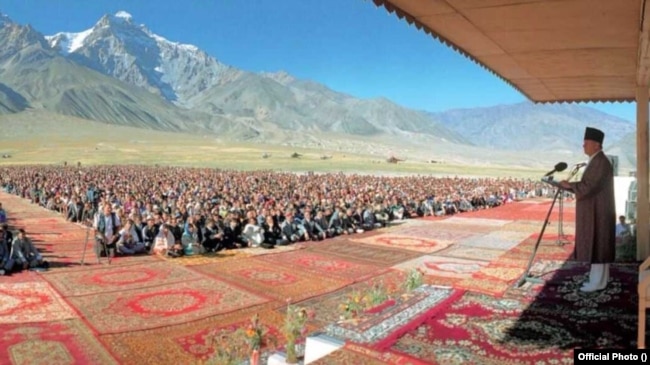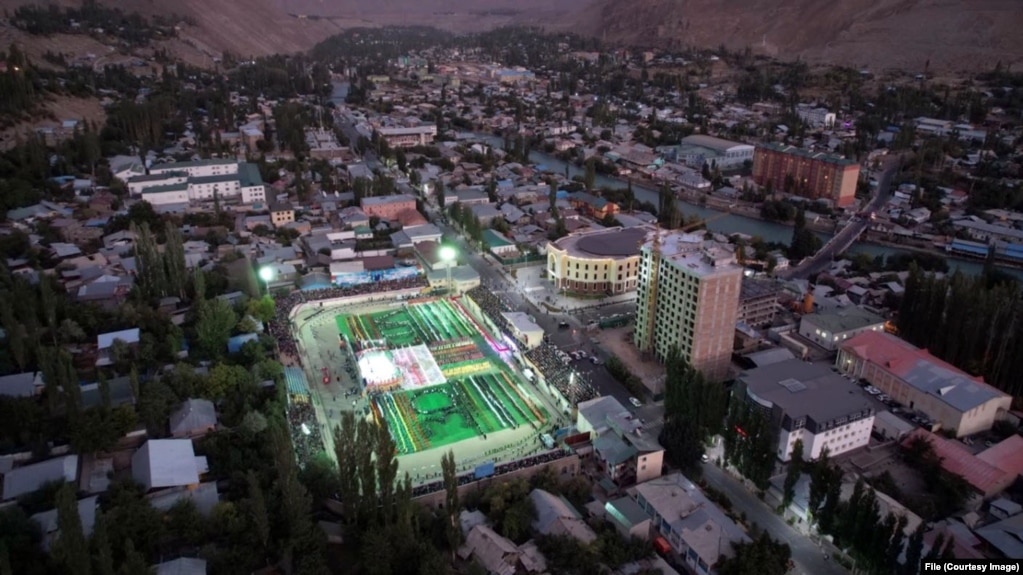
Prosecutors this month sought to appropriate a land plot in the provincial capital, Khorugh, where a Central Asia University campus funded by the Aga Khan Development Network (AKDN) is located. The land was purchased by the AKDN in the late 1990s, but officials now say the sales were illegal.
The AKDN is a private development agency funded by the Aga Khan, the imam of the Ismaili Shi’ite community. The majority of Gorno-Badakhshan’s some 250,000 people identify as Ismailis.
The nationalization of the AKDN properties in Gorno-Badakhshan comes amid a crackdown in the remote, autonomous region that intensified in the wake of anti-government protests there in May 2022.
According to Tajik authorities, at least 10 people were killed, and 27 others were injured on both sides during clashes between protesters and security forces. Local activists, however, say security forces killed more than 50 people, ranging from unofficial local leaders to ordinary protesters.
Dozens of people in Gorno-Badakhshan — including activists, journalists, and community leaders — have since been arrested in connection with the protests, with many receiving lengthy prison sentences.
Soon after the protests were dispersed by security forces, authorities nationalized a hotel — the Khorug Serena Inn — that was built by the AKDN in Khorugh’s picturesque Tem area.
The government went on to nationalize a recreational park in Khorugh in August. The AKDN had reportedly invested about $4 million in the remaking of the park between 2004 and 2005.
Speaking on condition of anonymity, sources close to the matter in Khorugh said the Aga Khan Medical Center was to be targeted next. The $25 million facility opened in 2018.
Last month, the government suspended the license of the Aga Khan Lycee that was established in Khorugh in September 1998.
It will be renamed the State Lycee for Gifted Students and operate under the auspices of the Education Ministry.
Tajik authorities haven’t publicly commented on the closure of the AKDN entities. There have been no official statements by the AKDN.
RFE/RL’s Tajik Service contacted government officials but didn’t receive a response to its queries. AKDN representatives in Khorugh declined to comment.
Dushanbe has struggled to assert control in Gorno-Badakhshan, where so-called informal local leaders enjoy more influence than government officials appointed by the central government.
Recurrent Protests
The region has been the scene of many anti-government protests that are met harshly by security forces over the years. Protest rallies are rare in the rest of the strictly controlled Central Asian nation where dissent is not tolerated.
Dozens of people were killed and wounded in Gorno-Badakhshan in 2012 in a clash between government forces and local militants sparked by the killing of a security official.
In 2014, at least three people were killed and several buildings set on fire in Khorugh in fighting between locals and security forces.
A new wave of protests erupted in Khorugh in November 2021 with up to 5,000 people attending daily rallies, according to local residents. At least one person was killed and several wounded in the protests that were sparked by the fatal shooting of a local man by police.
The four-day demonstration ended after negotiations between government officials and representatives of the protesters.
The government agreed to protesters’ demands that included dismantling police checkpoints and not opening criminal probes against the protest organizers.
But it launched a campaign against the informal leaders and other influential figures in the region — including those who had left the country.
‘Uneasy Relationship’
A longstanding mutual distrust between the government in Dushanbe and the people of Gorno-Badakhshan “is more palpable now than ever,” a local political observer told RFE/RL’s Tajik Service.
Speaking on condition of anonymity, the Khorugh native reiterated a relatively widespread sentiment that Dushanbe remains cautious of possible separatist ideas as well as the local population’s loyalty to the Aga Khan. The majority of people in the rest of Tajikistan adhere to Sunni Islam.
Most of the people living in Gorno-Badakhshan, who are also called Pamiris, have their own local languages.
“Suspicions among government officials toward the Aga Khan organizations have particularly deepened since the 2022 protests. Some officials even seem to believe these agencies provide financial backing to those who nurture separatist ideas, but this is a baseless suspicion,” the expert said. “The Aga Khan and his agencies don’t need or seek instability here.”
Edward Lemon, a Central Asia expert at Texas A&M University, says that “while the Aga Khan is their spiritual leader and Pamiris do have their own languages and religion, there is no viable pathway to independence or desire to be formally independent.”
“What Pamiris are seeking is their right to live a dignified life autonomously from government interference and repression,” he told RFE/RL. “But the government will not allow this.”
Lemon described the relationship between the Aga Khan and the Tajik government as “uneasy.”
Authorities in Tajikistan have never publicly alluded to any mistrust toward the AKDN presence in the country.
In the early 2000s, Tajik President Emomali Rahmon maintained what seemed to be a cordial relationship with the current Aga Khan — Shah Karim al-Husseini — who visited Tajikistan several times.
The Aga Khan, 86, last traveled to Tajikistan in 2012.
The AKDN first launched its projects in Tajikistan in the 1990s, providing humanitarian assistance to the country amid civil war.
The AKDN expanded its operation to other spheres, including education, finance, and health care, employing some 3,500 people across the country at its peak. It’s not known how many jobs were affected by the recent appropriation of the agency’s properties.

